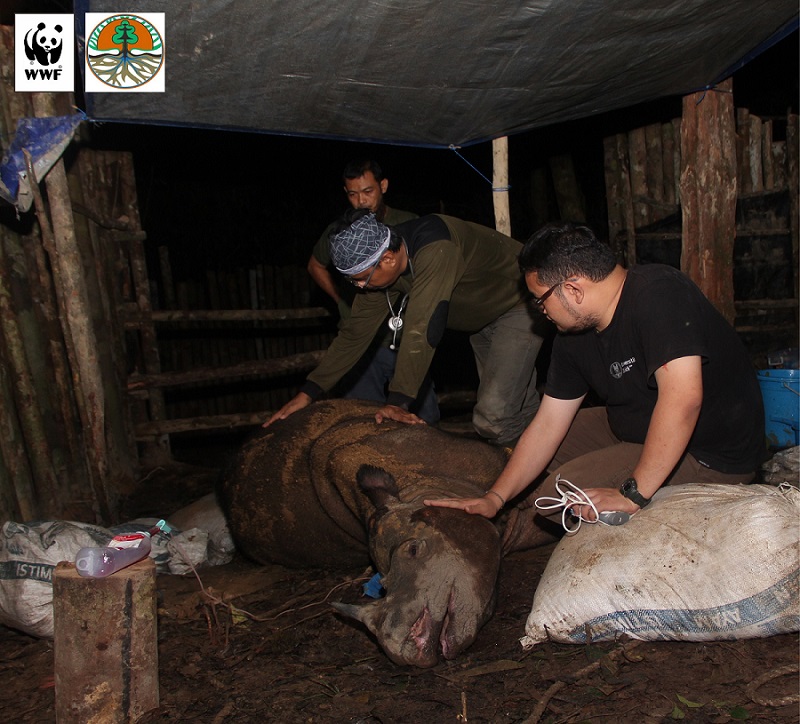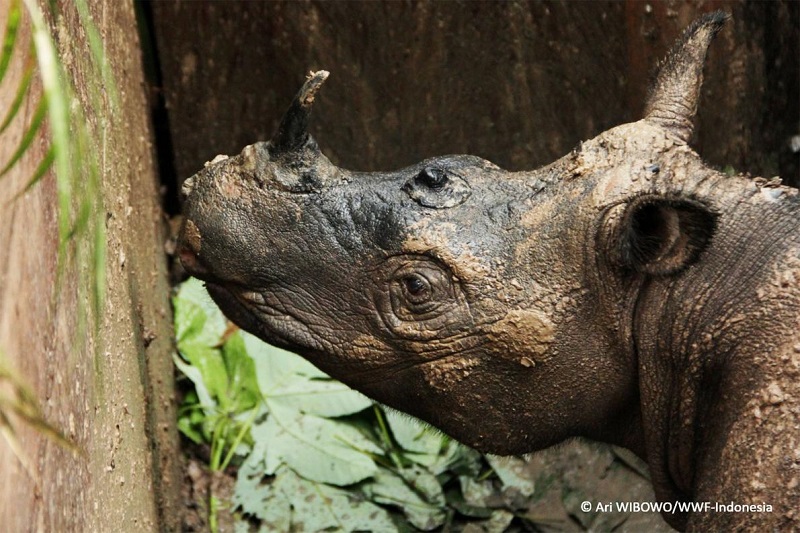- On Tuesday, the first Sumatran rhino to make contact with environmentalists in Kalimantan in 40 years died from a severe infection, making headlines across the world.
- A team of experts had tried for months to save her, but some conservationists are questioning whether the effort was mismanaged.
- Those involved in the rescue effort defend their response, arguing that the rhino was too ill to travel.
The death of an endangered Sumatran rhinoceros (Dicerorhinus sumatrensis) in Indonesian Borneo earlier this week sent the wildlife conservation community into deep mourning and raised questions about whether the animal would have had a better chance at survival without any human interference.
The first glimpse of the female rhino, affectionately known as Najaq, emerged last October when a hidden camera set by a team of wildlife experts, government officials and NGO workers caught her feeding on bushes in the Kelian protected forest in West Kutai district, East Kalimantan province.
The landmark discovery confirmed prior indications of a wild rhino population in the region, when scientists on an orangutan search in 2013 located rhino footprints there. That same year, they found more signs pointing to a population of at least 15 of the critically endangered creatures, the smallest and hairiest of the world’s five rhino species.
But the footage from the camera trap also showed that Najaq, thought to be four to five years old, had trouble walking; she had sustained an injury to her left hind leg from a nylon snare, the kind typically set by local poachers to catch wildlife.
Poaching and loss of habitat from deforestation and mining have hammered the population of the Sumatran rhino, a solitary creature that usually lives in dense mountain forests.
The 4,561-hectare Kelian forest where Najaq was discovered is a reclaimed gold mining concession previously run by Kelian Equatorial Mining, a subsidiary of the Anglo-Australian mining giant Rio Tinto. Industrial mining and oil palm operations in the region have taken their toll on the indigenous wildlife, prompting conservationists and the government to launch a project to capture all endangered animals and move them to a safer area.
After months of deliberation and tracking the likely routes traveled by Najaq, the team decided that capturing her with a pitfall trap was the least risky option, and began setting up the traps in January, said Widodo Ramono, executive director of the Indonesia Rhino Foundation (YABI), at a press conference in Jakarta on Wednesday. He added that each trap was lined with a mattress to reduce the risk of further injury to the animal.
On March 12, the team successfully captured Najaq in one of these shallow pits, and immediately moved her into a shed measuring seven meters a side, according to Anwar Purwoto, program director for the Sumatra and Kalimantan (Indonesian Borneo) regions at WWF Indonesia.
Upon examining Najaq, the team found that the meters-long ribbon of nylon from the snare that had been visible in the camera trap footage was gone. They also cleaned out shreds up to seven centimeters long of the nylon from her wound, which had become infected, Anwar said.
Two days after capturing her, the team moved Najaq to a 50-square-meter enclosure, known as a boma, which they later expanded to allow for medical treatment of the rhino.
Six veterinarians ministered to Najaq, deployed by the Environment and Forestry Ministry, the administration of Way Kambas National Park in Sumatra’s Lampung province, the Taman Safari Indonesia conservation network, the YABI, the WWF, and Bogor Agricultural University.
Anwar said the veterinarians conducted “round-the-clock observation” of Najaq’s health, and that a supply of antibiotics, anti-inflammatory drugs and vitamins was always available. They also consulted with rhino experts from Australia Zoo, Taronga Zoo in Sydney, and Cornell University in New York.
Najaq responded positively to the initial medical treatment, according to Muhammad Agil, one of the veterinarians, adding that her health and her appetite began to improve while in the boma.
“We wanted to get her fully fit again before we transferred her to a better facility,” Anwar said.
But her condition soon deteriorated, and on Tuesday, Najaq died – less than a month since her capture – with the infected wound on her leg cited as the cause of death by the veterinarians in their preliminary report.
Widodo said the infection may have spread to the heart, resulting in the rapid death of the rhino.
“Our only intention in capturing the rhino was to rescue her, especially considering her snare wound and the threats that existed in the area,” Anwar said.

As the news of Najaq’s death spread, conservationists and wildlife watchers from around the world questioned the Indonesian team’s efforts to treat the rhino’s infection and whether she would have been better off in the wild.
“Total incompetence from the start,” Erik Meijaard, a Jakarta-based conservation scientist coordinating the Borneo Futures Initiative, wrote on his Twitter account on Tuesday.
In a string of tweets that followed, Meijaard blamed “bad management” for contributing to Najaq’s death, noting that the injury was already some six months old by the time the rhino was captured. He also argued that the boma was insufficient for the treatment of the animal, and that the capture and treatment efforts lacked adequate involvement from leading international rhino experts.
Meijaard also questioned the decision not to transfer Najaq to a dedicated wildlife conservation facility, such as the Taman Safari park in West Java province or Way Kambas in Lampung.
“Serious soul searching needed. How could this have been prevented,” he tweeted. “Catching rhinos and keeping them alive need skills.”
The International Rhino Foundation also lamented Najaq’s death, writing in a Facebook post on April 5 that “[o]ur hearts are saddened by this devastating news from Kalimantan.”
It suggested that the death could have been prevented if the rhino had been transferred to the foundation’s local affiliate, the Sumatran Rhino Sanctuary in Lampung, which is currently home to six rhinos cared for by experienced veterinarians and keepers.
But transporting Najaq to one of these facilities – all on separate islands from Borneo – would have caused the rhino further stress and possibly exacerbated her condition, said Bambang Dahono Adji, director of biodiversity conservation at the Environment and Forestry Ministry.
“We did plan on moving her to a proper rhino sanctuary. But if even a healthy animal gets stressed out during air travel, how much worse is it for a sick one? It could die on the way to the facility and the government would be blamed for neglecting the animal’s health,” Bambang said.
He said moving Najaq to the nearest site with the requisite facilities would have meant hours of land transportation over winding roads, or half an hour by plane but with greater risk.
The WWF’s Anwar acknowledged that Najaq may have come under additional stress from being in new surroundings and encountering humans.
But that situation did not last long, according to Dedi Chandra, a veterinarian from the Way Kambas National Park. In a statement released by the WWF in March, Dedi said Najaq had begun to adapt to the situation in the shed where she was initially housed.
Anwar said that what prevented the team from transferring Najaq to a better-equipped facility was mainly her health, which despite improving at first was still considered not strong enough to allow her to travel.
“Moreover, we’d have to prepare the new place very well, which we were doing as we treated Najaq intensively,” he said.
A conclusive determination of the cause of death is expected within the next two weeks, pending an autopsy and further investigations, Anwar said.

Efforts to capture the remaining 14 Sumatran rhinos whose presence has been identified in the jungles of East Kalimantan will carry on despite Najaq’s death, said Bambang, the environment ministry official.
“We must learn from this experience,” he said, adding that the team must ensure the rhinos stay alive by giving them the best treatment possible.
“Involve the world’s best experts. First prepare plans and facilities then catch animals. No more dead rhinos,” Meijaard tweeted on April 7.
The International Rhino Foundation also called for better and more inclusive management in protecting the animal.
“Most importantly, we hope that the next rhino captured will be part of the much-needed Sumatran rhino metapopulation management strategy, while concurrent surveys are conducted to accurately determine the population in Kalimantan and appropriate long-term plans made,” the foundation wrote.
The ministry is currently funding the construction of a 200-hectare sanctuary within the Kelian forest at a location 150 kilometers from the site where Najaq was captured. The facility, modeled on the Sumatran Rhino Sanctuary, is expected to cost 30 billion rupiah ($2.3 million).
